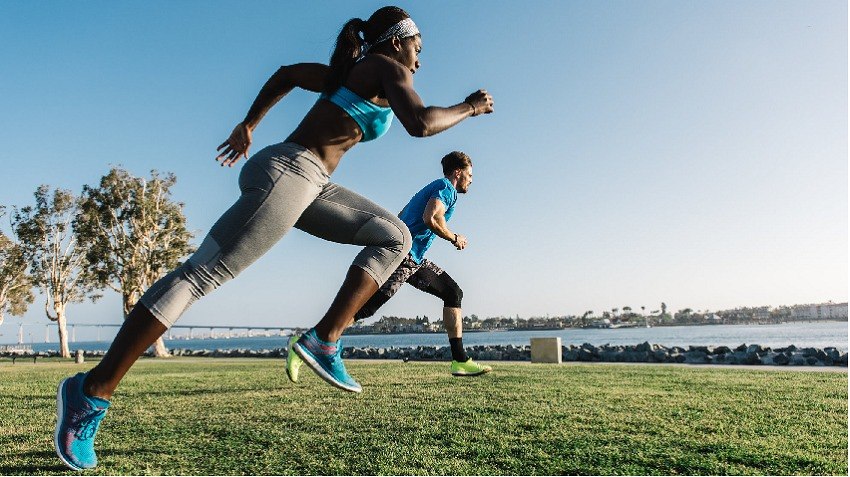How To Fuel Long Runs With Real Food
 Health & Fitness
Health & Fitness
Ask any runner about how to fuel during long runs, and you’ll hear a variety of opinions: “Drink sports drinks, they make it easier to stay hydrated!” “Don’t drink sports drinks, they’re full of artificial colors!” “Gels are a perfect fueling choice.” “Gels are too hard to get down.” “You should eat real food.” “You don’t really need to eat at all!”
Sound familiar? Trying to sort through all that can get exhausting!
As a sports RD, my goal is to help you sort fact from fiction, so here’s the deal: Fueling is important during long runs, but your choice of what to fuel with lends itself to flexibility. You’ll no doubt see a majority of athletes fueling with gels, blocks, sports drinks, or other commercial products. And there’s honestly nothing wrong with that—sports products are engineered to be absorbed properly and help you perform.
But you can also try fueling with “real foods”—meaning foods that you can buy from the grocery store that aren’t necessarily made for sports nutrition. As long as your stomach tolerates them, real foods can be just as effective as sports nutrition products.
How much to eat on a run
Let’s start with the basics—how much fuel to take in during training and racing. Your fuel should contain easily digestible carbohydrates, in the following amounts based on the length of time you are training or racing:
Less than 1:15: No fuel needed
1:15 to 3 hours: 30 to 60 grams of carbohydrate per hour
3+ hours: 30 to 90 grams of carbohydrate per hour (This is highly individualized; prolonged activity may require more fuel to maximize performance)
This means if you’re going out for a quick 5-miler, you don’t need any fuel. But if you’re going out for a long 15-mile training run, you’ll want to have some sort of carbohydrate to fuel your muscles.
If you’re sitting there shaking your head thinking, But I don’t need fuel, I’ve run 2 hours before without any, that might work for you, and that’s great. But these recommendations are based on the research, which the majority of athletes will perform better when they fuel properly according to these guidelines.
Real food options
You can definitely use real food options on your runs as long as your gastrointestinal system tolerates them well. Look for foods that are rich in easily digestible carbohydrates and that contain little fat or fiber, since these slow digestion and can cause stomach upset.
So what can you use? Bananas and raisins are two options that tend to work well for many endurance athletes and have been proven as effective as sports nutrition products in research. (Seriously—there are actual studies comparing bananas and raisins to gels and sports drinks.) One banana or ¼ cup raisins both provide about 30 grams of carbohydrate—falling in the lower end of our 30-60 grams/hour range.
Other options include (listed from “clean eating” to “not-so-clean-eating”):
Dates (2 medjool dates = 35 grams carbohydrate)
Applesauce squeeze packets (1 pack = 20 to 25 grams of carbohydrate)
Salted boiled potatoes or sweet potatoes (1 small potato or ½ large potato = 30 grams carbohydrate)
Low-fiber dry cereal (nutrition varies based on type)
White bread with honey or jam (1 slice + 2 Tbsp. = approximately 45 grams carbohydrate)
Pretzels (25 mini pretzels = approximately 30 grams carbohydrate)
Candy: Swedish fish, gummy worms, or jelly beans (check labels for nutrition facts)
Wondering how you might carry bananas or potatoes along the course? One trick is to mash them up before the race start and put them in a plastic baggie, then tear off the corner of the bag along the course and eat it like you would a gel.
How to build a real food fueling plan
To build your real food plan, simply choose an option or two that you enjoy and figure out the portion size that would equal 30-60 grams of carbohydrate per hour. Then plan to eat about that much every hour of training/racing, starting around the 30-45 minute mark. Keep a log so you can track the fueling plans that were successful for you during training. This will help you figure out your optimal race-day strategy.
But keep in mind that everyone’s body is different. Real food may help some excel, while others may prefer engineered sports nutrition products. Engineered products are generally customized to provide the right types and amounts of different types of sugars, so they may be more easily tolerated and absorbed compared to regular foods. There is no “right” answer. Find what works best for you!
Source: womensrunning.com




